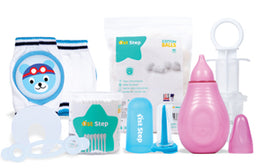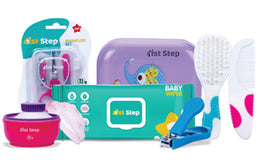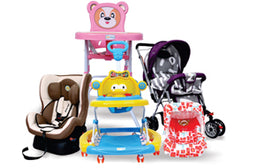How To Train Your Toddler To Walk?
Seeing your child taking his first steps is one of the most exciting and enthralling early milestones. The joy of accomplishment propels you to run around from dawn to dusk and be around them when they take their first steps.
Teaching your toddler to walk is a fun, enthralling, and nerve-wracking experience. Children go through several developmental stages, and all the turbulences get stirred up when your child attempts to achieve its first goal: taking its first step.
Your goal should be to support your child and provide them with a safe environment where they can learn this skill effectively. These physical milestones progress with the help of you being around them and practising some simple, easy steps to get your child on their feet and independent.
The period before your child takes its first steps may not be so much fun for you; however, once your baby is getting close to 1, you might be eager to experience the adventures it will bring in their journey to walk.
Your child learning to walk can be one of those memorable moments to cherish throughout your parenthood journey. The experience of training your toddler is fun as it helps to enhance and encourage cognitive and language development during this journey.
It is vital to give a little boost to your child for using their legs and enhancing their motor skills to start walking. This blog will offer you valuable insights into training your toddler to walk. We will provide you with some interesting tips and exercises to help prepare your baby to walk.
Let us unravel Certain Facts Regarding How Babies Develop Walking Skills.
Most toddlers start working independently at the beginning of 2-4 months of learning. Most of the babies show several signs that they will start walking soon. They will try to maintain strength and coordination to have an upright posture. During early attempts, they pull themselves into a standing position by holding onto someone or furniture.
They try to stand still for a few seconds, and as they get stronger, they can stand comfortably on their knees. As parents, you should perform simple steps to train your toddler to walk. It is vital to help your babies as during their initial attempt; they may lack muscle development, coordination and other body proportions to walk on their own. As parents, you should read more about baby development and try to enhance their motor skills. The following stages will help you understand the process much more straightforwardly.
- Six months: During this stage, the babies learn to sit on their own. Look out for physical signs and perform several routine steps to train your baby to walk accordingly.
- 6-9 months: It is during the stage when babies start crawling. Each new skill will build upon the unique skills and enhance the journey of your toddler's walking.
- 9-12 months: Babies would stand by, relying on the furniture, and explore several areas. Keep in mind that each baby is different, so their developmental skills may also vary depending on their motor skill growth.
- 11-13 months: You can finally expect your babies to move around and start walking. It is the beginning of experiencing several adventures in your parenthood. These life stages will help you discover insights on baby development and help you train your toddler to walk accordingly.
Watch out for several warning signs of late walkers that are as follows:
- Your baby doesnt walk around or babble
- Your baby doesn't show any physical movement until the 9th month or any sign of crawling
- Your baby doesn't rely on or require the support of furniture or anybody to stand on their own
- Your baby doesn't roll in either direction or crawl or sit without help
Exercises to help your baby walk
Here we present some exercises that will help you teach your baby to walk, improve your toddler's balance and enhance strength or coordination. - Sitting on a stool: When your baby can sit without help, you can get them a baby-sized chair and make them perform physical movements across your house. Ensure to stay around your toddler and make them perform these routine steps. You can make them move around with toys to enhance muscle strength and coordination. Several exercises will strengthen your baby's leg movement and shoulder muscles.
- Cruising: Your toddlers can practice walking by cruising back and forth next to objects or furniture. Slowly you can remove your hands, and they will start walking on their own and maintain balance.
- Walking with help by being behind them will help to enhance the process and make it easy for you to train your baby to walk.
- Navigating the corners and guiding your child while moving around is vital. You can make it more challenging by encouraging them to walk independently by removing the furniture. This can help them cruise and kick about, enhancing the development process.
Tips to get your toddler walking
- Use toys that entice your baby to stand and walk around. You can place them around your baby, improve their legs' physical movement, and strengthen their muscles. Get your toddlers a bouncy chair or a walker that helps improve their leg muscles.
- Line up furniture so your baby can cruise more easily or effortlessly. Ensure you are around them and monitor their performance. Get your baby a plush toy that will improve their cruising practice, refine their balance and boost their confidence while walking.
- Ensure that your baby has met previous milestones, i.e. they can crawl, stand while holding on, and take steps independently. You can use several baby walkers for your toddlers. A baby walker will give your baby the grip to move and comfortably engage around the surroundings. Our 1st step baby walker offers a 4-level height adjustment and a musical play tray. The mellow music of our baby walkers will keep your toddlers engaged and amused.
- Our baby walkers come with numerous features like push handles, which aid you in controlling your toddler while walking conveniently. You can use baby walkers to enable a safe play experience for your toddlers.
- Pull your baby into a standing position. They must grip your fingers and move around. This will help them support their weight, and they will be able to take the steps on their own. If they have hit all these stages, they will be able to walk independently. All these tips will help you train your toddler to walk.
- Go barefoot. Please don't make them wear socks, or don't buy indoor wearing shoes for your toddler. Make them move around bare feet that will strengthen their muscles. Avoid sneakers or tall booties as they can hinder the physical movement of the ankles. It will enhance sensory appeals or experience, as the feet will get exposed to several different textures and substances as these sensory signals will increase the awareness among the feet. As long as the indoor surfaces are clean, let them explore barefoot to build muscle tone around the ankles.
- To encourage your baby to walk, turn balancing into a game where they feel motivated to move and hover around. Count out loud how long they can stand and praise them for their balancing attempts.
- Expect some stops and starts while they are trying to walk around. Cheer and appreciate their efforts, and don't get stressed when they tumble or fall. Reduce their fear, and keep several objects around them, so they have something sturdy to hold onto if they fail.
- Strengthen their muscles with standing and squatting activities. As they gain their balance, you can gradually reduce your support and assist them while walking.
- Make a beat and dance. If your toddler isn't interested in standing simply, you can indulge them in dancing or music. It will make them interested in walking around, and enhance their leg movement, thus improving their motor skills.
Conclusion
Enjoy having fun with your toddler taking its first steps and watch them develop this new skill. Do not miss these moments, as these are the biggest milestones that will always be memorable and cherished during your parenthood. I hope these above-listed tips and exercises will help you train your toddler to walk and help them explore more.
 Feeding & Nursing
Feeding & Nursing Safety & Grooming
Safety & Grooming  Bathing & Diapering
Bathing & Diapering Baby Gear
Baby Gear Mother Needs
Mother Needs Muslin Essentials
Muslin Essentials Baby Toys
Baby Toys












